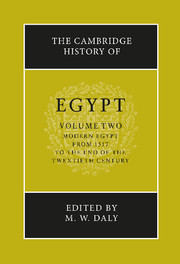Book contents
- Frontmatter
- 1 Ottoman Egypt, 1525–1609
- 2 Egypt in the seventeenth century
- 3 Egypt in the eighteenth century
- 4 Culture in Ottoman Egypt
- 5 The French occupation of Egypt, 1798–1801
- 6 The era of Muhammad ’Ali Pasha, 1805–1848
- 7 Egypt under the successors of Muhammad ’Ali
- 8 The Egyptian empire, 1805–1885
- 9 The ‘Urabi revolution and the British conquest, 1879–1882
- 10 The British occupation, 1882–1922
- 11 Social and economic change in the “long nineteenth century”
- 12 The liberal age, 1923–1952
- 13 Egypt: society and economy, 1923–1952
- 14 Republican Egypt interpreted: revolution and beyond
- 15 Modern Egyptian culture in the Arab world
- Select Bibliography
- Index
- References
3 - Egypt in the eighteenth century
Published online by Cambridge University Press: 28 March 2008
- Frontmatter
- 1 Ottoman Egypt, 1525–1609
- 2 Egypt in the seventeenth century
- 3 Egypt in the eighteenth century
- 4 Culture in Ottoman Egypt
- 5 The French occupation of Egypt, 1798–1801
- 6 The era of Muhammad ’Ali Pasha, 1805–1848
- 7 Egypt under the successors of Muhammad ’Ali
- 8 The Egyptian empire, 1805–1885
- 9 The ‘Urabi revolution and the British conquest, 1879–1882
- 10 The British occupation, 1882–1922
- 11 Social and economic change in the “long nineteenth century”
- 12 The liberal age, 1923–1952
- 13 Egypt: society and economy, 1923–1952
- 14 Republican Egypt interpreted: revolution and beyond
- 15 Modern Egyptian culture in the Arab world
- Select Bibliography
- Index
- References
Summary
General observations
Egypt continued its drift toward autonomy during the course of the eighteenth century, moving at the same time from dominance by households to rule by individuals. As it emerged from the generally passive condition imposed on it by two centuries of Ottoman domination and freely developed closer links with Europe under the leadership of aggressive beys of a new and ambitious Mamluk household, Egypt assumed a central importance in European strategic planning that it has never lost. Much of this importance rested on a unique geographic position, but Egypt sustained a vibrant economy of its own. It remained the richest and most important Ottoman province, for it distributed to various regions of the Ottoman empire (and increasingly, as the century wore on, to European states eager for its trade) agricultural bounty of such crops as rice, sugar, and wheat as well as a broad range of products, chiefly Yemeni coffee, from Africa, Asia, and the Red Sea region.
Despite the continuing tyranny of its military establishment, the seemingly incessant outbreaks of violence among competing military households, and frequent visits of plague and pestilence, Egypt’s economy remained strong well into the century. During a lengthy period of political stability in mid-century the economy provided prosperity for the upper and middle classes, sustained a considerable population increase, and supported the physical expansion of Cairo and the port cities.
By the second half of the century, however, the long-term effects of Europe’s economic expansion – the direct purchase of coffee, for instance, by the Europeans from the Yemen and their introduction into Middle Eastern markets of coffee and rice grown in the New World – began to have a debilitating impact on the Egyptian economy.
- Type
- Chapter
- Information
- The Cambridge History of Egypt , pp. 59 - 86Publisher: Cambridge University PressPrint publication year: 1998
References
- 9
- Cited by



